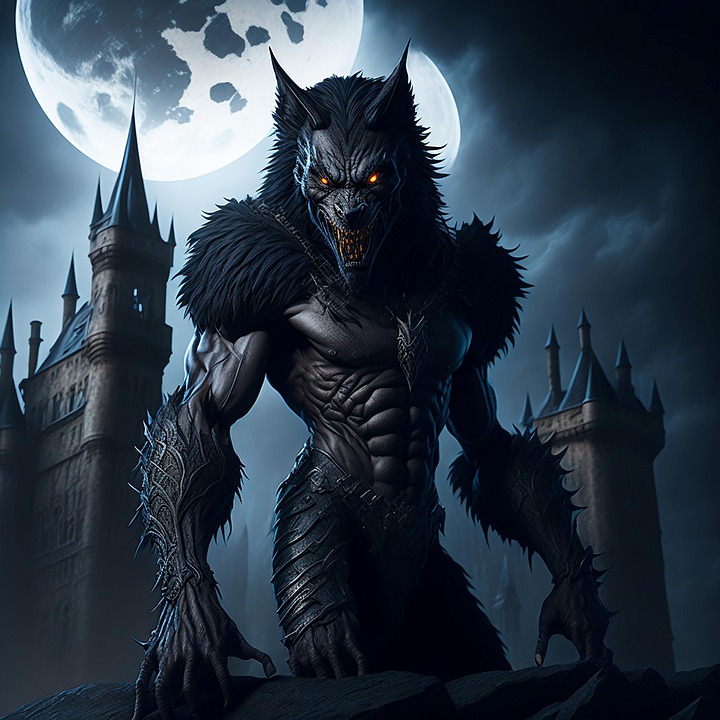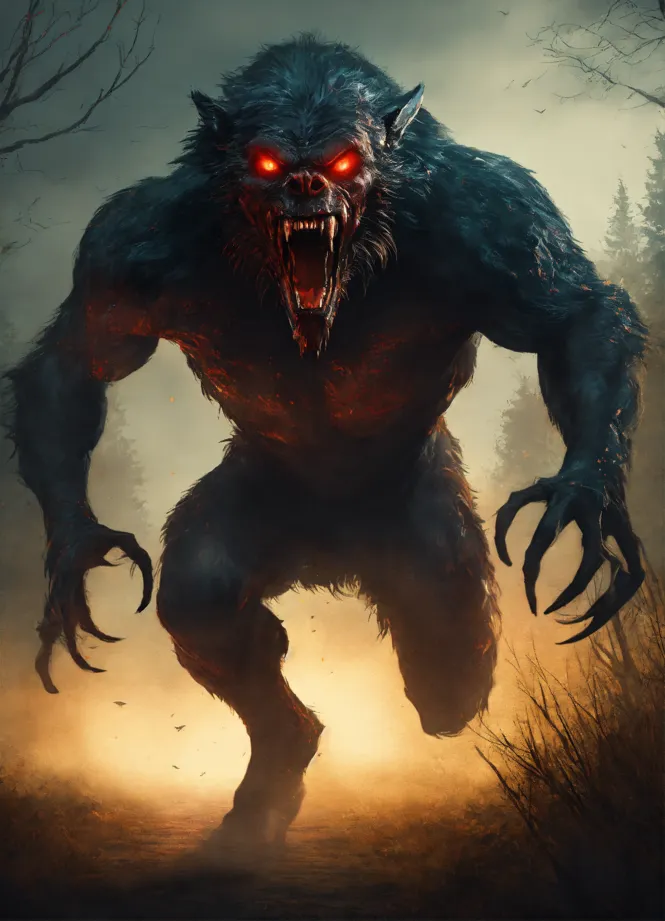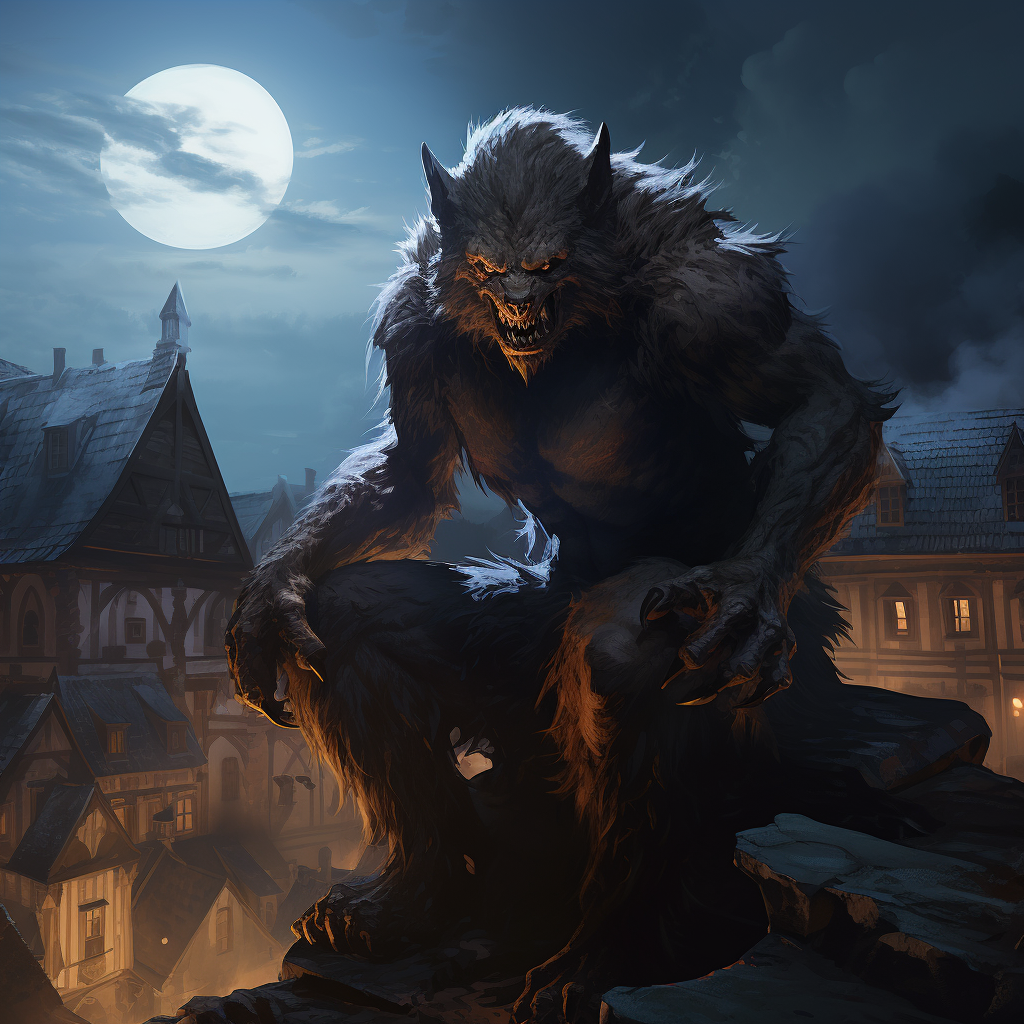Have you ever stopped to truly look at werewolf artwork? It's a fascinating subject, isn't it? For so many people, these powerful creatures, part human and part wolf, really capture the imagination. We see them in stories, on screens, and, of course, in countless pieces of art. There is just something about their shifting forms and raw strength that draws us in, a bit like a primal call.
The stories of werewolves, or lycanthropes as they are sometimes called, have been around for a very long time, as a matter of fact. They've captivated human minds for centuries. Think about it: a person who changes into a wolf, maybe at night, to hunt or just to be wild. This idea has sparked so much creativity, from ancient tales told around fires to the big blockbuster movies we see today. It's a journey, really, through human fears and desires, all wrapped up in a creature that is both familiar and terrifying.
So, how does all this rich history and folklore show up in werewolf artwork? Well, it's pretty incredible to see the different ways artists have brought these legends to life. From the earliest drawings to today's digital masterpieces, each piece tells a part of the werewolf story. It reflects how we, as people, have seen these creatures over time, and what they mean to us. We will explore this captivating visual history, looking at how artists interpret these mythical beings, and what makes their depictions so compelling, just really something special.
Table of Contents
The Deep Roots of Werewolf Lore
Early Depictions: Folklore's Visual Beginnings
The Evolution of Werewolf Art Through the Ages
From Manuscripts to Prints
The Romantic Era and Beyond
Modern Interpretations: Film, Comics, and Digital Art
Themes and Meanings in Werewolf Artwork
The Transformation: A Central Artistic Moment
Humanity Versus Bestiality
Fear, Power, and the Wild
Iconic Elements in Werewolf Art
Understanding the "People Also Ask" About Werewolf Artwork
What are the different styles of werewolf artwork?
How has werewolf art evolved from folklore to modern media?
Who are some famous artists known for werewolf depictions?
The Deep Roots of Werewolf Lore
The concept of a human changing into a wolf is, honestly, a very old one. In European folklore, a werewolf is often described as a man who turns into a wolf when the moon is out, or perhaps at night. This wolf then might hunt animals, people, or even corpses. But then, by day, the person goes back to their human shape. It's a powerful image, really, this back-and-forth between two forms.
Where do these stories come from? Well, they've existed for thousands of years, according to some experts. Werewolves are, in some legends, people who morph into vicious, strong wolves. Others are seen as a sort of mutant mix of human and wolf. The idea of them has been around for so long, and it's quite interesting how it has stuck with us. Experts like those today.com talked to, including Woods, break down the origin, facts, and history of these creatures, or lycanthropes, as they are officially termed. They help us see how deep these roots go, just really deep.
The lore itself has variations, too. For instance, in werewolf folklore, there are said to be two types of cursed werewolf. There are those who simply deny the curse, trying to fight it, and then there are those who just embrace it, giving in to their wild side. This distinction, this choice, is something that artists have often explored in their werewolf artwork. It adds layers to the visual story, making the creatures more than just monsters. It makes them characters with a dilemma, you know, a real struggle.
Early Depictions: Folklore's Visual Beginnings
Before cameras or widespread printing, how did people show what a werewolf looked like? They drew them, of course. Early werewolf artwork was probably found in old manuscripts, or maybe even on simple carvings. These first images were likely quite basic, but they still captured the scary idea of a human turning into a beast. They were meant to convey the danger and the unnaturalness of the transformation. It was a way to share the stories, a visual aid for the tales told around the fire, more or less.
These early pieces often focused on the key aspects from the lore. The wolf form, the human elements still visible, the sense of wildness. They weren't always about detailed anatomy, but about the feeling of dread or power. You can see how the folklore, like the idea of a human who turns into a wolf at night, directly shaped these first visual attempts. It's a direct connection, really, from the spoken word to the drawn line, just really clear.
Sometimes, these early artistic efforts also showed the fear people had. A werewolf, also known as a lycanthrope, is a creature that can hide its ears and tail, making it look like a human but also a wolf. Most people fear them because of how they look. This fear, this unease about something that is both human and not, was a powerful motivator for artists. They tried to capture that unsettling feeling, that sense of something being wrong, in their drawings. It was, in a way, a way to process the scary stories, a little bit like facing your fears on paper.
The Evolution of Werewolf Art Through the Ages
As time moved on, so did the way artists depicted werewolves. Each period brought new styles, new techniques, and new ways of thinking about these creatures. The change in art often mirrored the change in how society viewed these legends, you know, what they meant to people at different times.
From Manuscripts to Prints
In the medieval period, werewolf images appeared in bestiaries and other illuminated manuscripts. These were often stylized, showing the wolf form with perhaps some human-like posture or features. They were often illustrative, meant to accompany the written stories. Later, with the invention of the printing press, werewolf artwork could spread more widely. Woodcuts and engravings brought these images to a larger audience, allowing more people to see and share in the visual interpretations of the lore. These prints often emphasized the monstrous side, the danger, and the raw, untamed nature of the beast, just really focusing on that.
The Romantic Era and Beyond
The Romantic era, in the 18th and 19th centuries, brought a new depth to werewolf artwork. This period loved the wild, the emotional, and the supernatural. Artists began to explore the transformation itself, showing the agony and the power of the change. They often focused on the human side of the werewolf, the struggle within. This was also when some of the more famous myths, like silver bullets and the full moon, started to become more popular, though "My text" tells us these have more to do with Hollywood than ancient folklore. Still, these ideas found their way into the art, influencing how artists portrayed the creatures. It was a very expressive time for this kind of subject, you know, a time of big feelings.
Modern Interpretations: Film, Comics, and Digital Art
The 20th and 21st centuries have seen an explosion of werewolf artwork, especially with the rise of film, comic books, and digital media. Movies, for example, brought the transformation to life in a dynamic way, influencing how artists imagined the process. Comic books allowed for detailed, sequential storytelling of werewolf tales, giving artists a chance to explore character design and action. Digital art, well, it offers endless possibilities for creating incredibly detailed and realistic, or even highly stylized, werewolf forms. Artists today can show the creature in ways never before possible, from the terrifyingly real to the fantastically monstrous. This article delves deeper into the rich tapestry of werewolf mythology, examining its historical roots, cultural variations, and psychological implications while debunking myths, which is something artists often explore in their work today, too, you know, that blend of old and new.
Themes and Meanings in Werewolf Artwork
Beyond just showing a human-wolf hybrid, werewolf artwork often explores deeper themes. Artists use these creatures to talk about parts of the human experience. It's not just about what they look like, but what they represent, really.
The Transformation: A Central Artistic Moment
Perhaps the most compelling theme in werewolf artwork is the transformation itself. This is the moment of change, often depicted with pain, struggle, and a shift from human to beast. Artists capture the stretching skin, the growing fur, the changing bone structure. It's a powerful visual metaphor for losing control, for giving in to primal urges, or for a forced change. This moment of transition is often shown as both terrifying and, in a way, liberating, you know, a release of something wild.
Humanity Versus Bestiality
A core idea behind the werewolf is the conflict between human reason and animal instinct. Werewolf artwork often highlights this tension. Is the creature more human, or more wolf? Does it retain any of its former self, or is it completely consumed by the beast? This question of identity is a very rich area for artists to explore. It makes us think about our own wild sides, and where the line between civilization and savagery truly lies, just a little bit, perhaps.
Fear, Power, and the Wild
Werewolves have captivated human imagination for centuries, and their artwork reflects this. They represent fear, especially the fear of the unknown or the monster within. But they also represent raw power, the strength of the wild, untamed nature. Some pieces of art show them as terrifying predators, while others portray them as majestic, powerful beings. It's a duality that makes them endlessly fascinating. They are, according to some legends, people who morph into vicious, powerful wolves, but others are a mutant combination of human and wolf. This range of interpretation gives artists so much to work with, really, a wide canvas.
Iconic Elements in Werewolf Art
Certain elements have become classic in werewolf artwork, thanks in part to popular culture. Even though "My text" mentions that silver bullets, the full moon, and wolfsbane have more to do with Hollywood than ancient folklore, these things have become iconic visual cues. So, you'll often see them in art.
- The Full Moon: This is a very common backdrop for werewolf transformations, symbolizing the trigger for their change. It adds a sense of mystery and cosmic influence.
- Shadows and Darkness: Werewolves are creatures of the night, so artists often use deep shadows and dark settings to create a mood of suspense and danger.
- Aggressive Postures: Many artworks show werewolves in dynamic, attacking, or snarling poses, emphasizing their predatory nature.
- Torn Clothing: A simple yet effective way to show the transformation's violence is to depict torn clothing, hinting at the human form that was just shed.
- Glowing Eyes: Often, artists give werewolves piercing, glowing eyes to convey their supernatural power and predatory gaze.
These elements, while sometimes rooted in more recent interpretations, have become powerful symbols in the visual language of werewolf art. They help instantly communicate the creature's identity and its connection to the wild, just really quick recognition.
Understanding the "People Also Ask" About Werewolf Artwork
When people search for "werewolf artwork," they often have specific questions in mind. Let's look at some common ones and how they relate to what we've discussed.
What are the different styles of werewolf artwork?
Werewolf artwork comes in so many styles, it's almost hard to count them all. You have everything from very traditional, almost classical depictions that focus on the folklore, to highly stylized comic book art, to realistic digital paintings. There's also gothic art, which emphasizes the horror and mystery, and fantasy art, which might make them more heroic or majestic. Some artists go for a grotesque, body-horror approach to the transformation, while others create sleek, almost beautiful, monstrous forms. The style often depends on the artist's vision and the specific aspect of the werewolf they want to highlight, you know, what they feel about it.
How has werewolf art evolved from folklore to modern media?
It's evolved quite a bit, actually. Early art was simpler, focusing on the basic idea of a human-wolf hybrid, often with a moralistic or cautionary tone. As printing became common, more detailed and dramatic scenes emerged. The Romantic period added emotional depth and focused on the internal struggle. Then, with film and special effects, the visual transformation became a central focus, often showing the agonizing process in detail. Today, digital art allows for incredible realism or fantastical exaggeration, pushing the boundaries of design. The core idea remains, but the visual language has grown richer and more varied, allowing for so many different ways to tell the story, just really diverse.
Who are some famous artists known for werewolf depictions?
While there isn't one single "famous werewolf artist" like there might be for a particular landscape painter, many artists have contributed significantly to the visual lore. In classical art, you might find illustrations in old texts, though not always attributed to a single "famous" name. In modern times, many concept artists and illustrators for film, games, and comics have created iconic werewolf designs. Think of the creature designs from movies like "An American Werewolf in London" (Rick Baker's work, for instance, is legendary) or "The Howling." These artists, while perhaps not household names in the traditional art world, are certainly celebrated within the horror and fantasy art communities for their contributions to werewolf imagery. You can also find many talented independent artists on platforms like ArtStation or DeviantArt who specialize in creature design, including werewolves, showcasing a lot of skill and creativity.
To learn more about werewolves, or lycanthropes as they are officially termed, today.com talked to woods and other experts who break down the origin, facts and history. This deep understanding of the lore truly informs the artwork we see. It helps artists give their creations a sense of history and meaning, connecting back to those ancient stories that still resonate with us. For instance, you can find more information about these creatures and their place in folklore at a well-known folklore resource, like Folklore Studies Online. This connection between the old tales and the new art is what makes werewolf artwork so enduring, really, a timeless appeal.
- Halo Nightclub Atlanta
- Chimocurves Onlyfans
- Sean Matthew Landon
- Cafenation Cafe Roastery
- Ronald Ollie



Author Details:
- Name : Prof. Alexandria Gorczany DVM
- Username : kiana65
- Email : ylabadie@yahoo.com
- Birthdate : 1992-02-06
- Address : 669 Tillman Mountain Suite 252 West Natmouth, WV 63073-0901
- Phone : +12163882345
- Company : Bogisich, Paucek and Bosco
- Job : Housekeeping Supervisor
- Bio : Et rerum labore quia sed sed doloremque dolorum. Quo hic nisi quo quos quas fugiat. Voluptatibus est rerum ab corporis rem. In enim porro voluptas optio tempore.
Social Networks
Instagram:
- Url : https://instagram.com/nthiel
- Username : nthiel
- Bio : Natus soluta rerum nulla fugiat. Ea ut facilis eveniet. In qui repellat perspiciatis fugit.
- Followers : 6372
- Following : 55
Twitter:
- Url : https://twitter.com/nathen8374
- Username : nathen8374
- Bio : Consequuntur numquam optio sint architecto magnam. Harum libero nulla quia ut voluptatibus repudiandae culpa. Aut voluptatibus incidunt perferendis.
- Followers : 5803
- Following : 961
Tiktok:
- Url : https://tiktok.com/@nathen5034
- Username : nathen5034
- Bio : Architecto excepturi quia blanditiis quaerat rerum libero ut dolore.
- Followers : 4511
- Following : 2080
Linkedin:
- Url : https://linkedin.com/in/nathenthiel
- Username : nathenthiel
- Bio : Tempora officiis placeat veniam accusantium.
- Followers : 1273
- Following : 2690
Facebook:
- Url : https://facebook.com/nthiel
- Username : nthiel
- Bio : Iusto quia totam eum iusto excepturi minus et.
- Followers : 1509
- Following : 325
